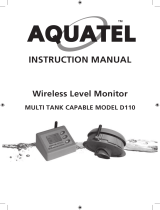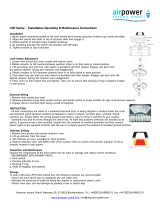
INSTRUCTIONS DE MISE EN SERVICE
INSTRUCTIONS FOR START-UP
BETRIEBSANLEITUNG
NR 1043_FQ_revD_A/F/D
Art: 5100022
FQ
Gamme
Range
Reihe
Page is loading ...
Page is loading ...

4
1 CAUTIONS BEFORE COMMISSIONING
Warning: This actuator includes one compressed spring which can be dismounting only with special
tools. The control box remains accessible without having to use special tools.
2 ELECTRICAL CONNECTIONS AND OPERATION
• Check the power supply type.
• When the power supply is OFF, the actuator is on one of its mechanical stops.
An incorrect electric motor rotation could damage the actuator.
Then check the electric rotation direction.
• Do not energize the brake.
• Pull down the declutch lever (when the actuator has
an handwheel).
• Put the power on the motor and check the right
rotation direction (arrow on the motor).
• Connect the travel limit switches and check by swit-
ching them if they are functioning correctly.
• After above controls, do not forget to plug (energize)
the brake.
3 MECHANICAL STOPS SETTING
When the power supply is OFF, the actuator is on one of its mechanical stops. To modify this position,
screw or unscrew the corresponding mechanical stop then lock the nut on the screw to keep
the position. The mechanical stops and nuts are located outside the actuator housing.
4 TRAVEL LIMIT SWITCHES SETTING
The cams actioning the microswitches are located in a block which is driven by the main shaft.
1 - Put a screwdriver in the corresponding slot of cam to set.
2 - Push slightly to engage and turn left or right according to the required cam position.
3 - Remove the screwdriver and ensure that the button has come back to its original
position, thus locking the cam in the chosen position.
4 - Make sure that the electric motor has stopped by the travel limit switch and not by the
mechanical stop.
Caution: The travel limit switches have always to cut off the motor power supply before to reach
the mechanical stops.
5 POSITION INDICATOR SETTING
The dial indicator is fixed on a shaft. Unlock the screw and position the arrow in front of the corres-
ponding position shown on the cover then lock the screw.

5
6 MANUAL OPERATION
In case of power failure the actuator can be used through the handwheel (only on types FQR).
Proceed as follows:
• Unlock if necessary, the clutching lever (on the side
of the actuator) by removing the padlock (optional equipment).
• Pull down the lever to engage the handwheel.
• Turn the handwheel to drive the valve.
Warning: When the lever is in a manual position, no fail-safe
action is available.
To bring the actuator back into its safe position, place the lever
in its original position. The remaining energy of the spring will
allow an automatic come-back in the safe position.
Page is loading ...
Page is loading ...

SUBSIDIARIES
BELGIUM
BERNARD CONTROLS
BENELUX
BRUXELLES
info.benelux@bernardcontrols.com
Tel +32 (0)2 343 41 22
CHINA
BERNARD CONTROLS CHINA
PEKIN
inquiry.asia@bernardcontrols.com
Tel +86 (0) 10 6789 2861
GERMANY
BERNARD CONTROLS DEUFRA
TROISDORF
bcd.mail@bernardcontrols.com
Tel +49 22 41 98 340
ITALIA
BERNARD CONTROLS ITALIA
MILAN
info.it@bernardcontrols.com
Tel +39 02 931 85 233
KOREA (REPUBLIC OF)
BERNARD CONTROLS KOREA
SEOUL
inquiry.asia@bernardcontrols.com
Tel +82 (0)2-553-5957
SINGAPORE
BERNARD CONTROLS SINGAPORE
SINGAPORE
bcsg.info@bernardcontrols.com
Tel +65 65654227
BERNARD CONTROLS SPAIN
MADRID
info.spain@bernardcontrols.com
Tel +34 91 30 41 139
UNITED STATES
BERNARD CONTROLS Inc
HOUSTON
bsales@bernardcontrols.com
Tel +1 281 578 66 66
OFFICES
DUBAÏ
BERNARD CONTROLS
MIDDLE-EAST
bernact@emirates.net.ae
Tel +971 4 344 2010
MOSCOW
BERNARD CONTROLS
RUSSIA
youri.otradine@bernardcontrols.com
Tel +(7 499) 251 06 54
or +(7 916) 911 28 42
AGENTS AND
DISTRIBUTORS
AMERICAS
Information on our network
www. bernardcontrols.com
or
Back Office
BERNARD CONTROLS Inc.
bsales@bernardcontrols.com
Tel +1 281 578 66 66
BRAZIL
JCN
SAO PAULO
Tel +55 11 39 02 26 00
ASIA
Information on our network
www. bernardcontrols.com
or
To contact our distributors
Back Office
BERNARD CONTROLS ASIA
inquiry.asia@bernardcontrols.com
Tel +86 10 6789 2861
EUROPE - MIDDLE EAST
AFRICA
Information on our network
www.bernardcontrols.com
or
Back Office
BERNARD CONTROLS
mail@bernardcontrols.com
Tel +33 (0)1 34 07 71 00
or
Contact directly agents/distributors
AUSTRIA
IPU ING PAUL UNGER
WIEN
Tel +43 1 602 41 49
CZECH REPUBLIC
FLUIDTECHNIK BOHEMIA s.r.o.
BRNO
brno@fluidbohemia.cz
Tel +420 548 213 233-5
DENMARK
ARMATEC A/S
COPENHAGUEN
Tel + 45 46 96 00 00
EGYPT
ATEB
ALEXANDRIA
gm@atebco.com
Tel +203 582 76 47
FINLAND
OY ARMATEC AB
HELSINKI
+358(0)9 887 434 11
GREECE
PI&MS Entreprises Ltd
ATHENS
Tel +30 210 608 61 52
HUNGARY
APAGYI TRADEIMPEX KFT
BUDAPEST
Tel +36 1 223 1958
MOROCCO
AQUATEL sarl
CASABLANCA
Tel +212 22 66 55 71
POLAND
ARNAP Z.o.o.
BIELSKO-BIALA
Tel +48 33 81 84004
MARCO
VARSOVIE
Tel +48 22 864 55 43
SOUTH AFRICA
A-Q-RATE AUTOMATION CC
BERTSHAM
Tel +27 11 432 58 31
SWITZERLAND
MATOKEM AG
ALLSCHWIL
info@matokem.ag
Tel +41 61 483 15 40
TURKEY
OTKONSAS
ISTANBUL
Tel +90 216 326 39 39
UNITED KINGDOM
ZOEDALE Plc
BEDFORD
Tel +44 12 34 83 28 28
Exhaustive list of agents
and distributors on
www.bernardcontrols.com
BERNARD CONTROLS
4 rue d’Arsonval - BP 70091 - 95505 Gonesse Cedex - France
Tel: +33.1. 34.07.71.00 - Fax: +33.1.34.07.71.01
E-mail: mail@bernardcontrols.com
Internet: http://www.bernardcontrols.com
-
 1
1
-
 2
2
-
 3
3
-
 4
4
-
 5
5
-
 6
6
-
 7
7
-
 8
8
Bernard Controls Gamme FQ Series Installation & Operation Manual
- Type
- Installation & Operation Manual
- This manual is also suitable for
Ask a question and I''ll find the answer in the document
Finding information in a document is now easier with AI
in other languages
- français: Bernard Controls Gamme FQ Series
- Deutsch: Bernard Controls Gamme FQ Series
Related papers
-
Bernard Controls ASM Range Installation & Operation Manual
-
Bernard Controls BT range BT SWITCH Installation & Operation Manual
-
Bernard SQ Series Installation, Start-Up And Maintenance Instructions
-
Bernard EZ Series Installation, Start-Up And Maintenance Instructions
-
Bernard Controls FQ Range ATEX Installation & Operation Manual
-
Bernard Controls AT Range Installation & Operation Manual
-
Bernard Controls BT range Startup Manual
-
Bernard Controls AQL Series Startup Manual
-
Bernard Controls ST6 Instructions For Start-Up
-
Bernard Controls AT Range AT SWTICH Installation & Operation Manual
Other documents
-
Bernard FQ Series Operating instructions
-
Bernard MS102 Instructions For Use Manual
-
Bernard Intellibus Instructions For Use Manual
-
Bernard LEB Installation, Start-Up And Maintenance Instructions
-
 Aquatel D110-S User manual
Aquatel D110-S User manual
-
Gemu LSF User manual
-
Honeywell MN6105VAV Installation Instructions Manual
-
Bernard Minigral+ User manual
-
V2 Elettronica V2 Blitz Owner's manual
-
 AirPower LSB Series Installation, Operating, & Maintenance Instructions
AirPower LSB Series Installation, Operating, & Maintenance Instructions









